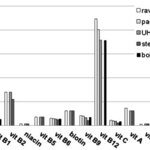Microbiology
A rudimentary form of life,
Haloferax volcanii, part of the family of single-celled organisms called archaea that until recently were thought to be a type of bacteria, is found in some of the harshest environments on earth. Now researchers have determined it is able to sidestep normal replication processes and reproduce by the back door.
Archaea were originally discovered in extreme environments and can survive at very high or very low temperatures, or in highly salty, acidic or alkaline water. They form one of the three distinct branches of life along with bacteria and eukaryotes, which are…

A team of international scientists has isolated a very close relative of the Severe Acute Respiratory Syndrome coronavirus (SARS-CoV) from horseshoe bats in China, confirming them as the origin of the virus responsible for the 2002-3 pandemi, which killed 774 people of the 8094 people infected and led to diagnosed cases across the world, impacting international travel and trade.
Horseshoe bats are found around the world, including Australia and play an important ecological role. Their role in SARS-CoV transmission highlights the importance of protecting the bat's natural environment so they…

Since their invention, antibiotics have made it possible to cure lethal bacterial infections but in recent years the efficacy of antibiotics has been drastically reduced due to overuse and resulting bacterial resistance.
Today, bacteria resistant to nearly all known antibiotics are prevalent in many parts of the world and in Europe alone more than 25,000 people die each year from infections caused by multi-resistant bacteria.
Researchers from
University of Copenhagen and the University of British Columbia
have developed a substance called HDM-4, which stands for Host Defence…

As a kid, I drank raw milk. It didn't kill me. If I got sick from it, I have no idea, kids get sick from lots of things and just want to get back to playing baseball, we weren't thinking about how we got ill.
But you shouldn't drink raw milk, even though I adapted to it just fine, regardless of what someone selling you something tries to claim. There is a reason foodborne illnesses have plummeted from a hundred years ago and that reason is pasteurization. Dr. Hannah Gould, senior epidemiologist with the CDC's Enteric Diseases Epidemiology Branch, noted that even today raw milk is responsible…

Nothing says weight loss like botulism.
Obesity is a growing problem across the globe. Being overweight can lead to severe diseases and conditions, like diabetes and heart problems. The World Health Organization estimates that obesity is responsible for 2 to 8 percent of health care costs and 10 to 13 percent of deaths in various parts of Europe.
Research from the Norwegian University of Science and Technology has had promising experimental results using Botox, commonly known for transforming the faces of Bruce Jenner and Joan Rivers into plastic masks, as a weight loss tool in rats.…

In Antarctica's Vestfold Hills, Deep Lake has been isolated from the ocean for the last 3,500 years ago, a result of Antarctic continent rising that has left a saltwater ecosystem that remains liquid, even in extreme cold.
Deep Lake also provides researchers a unique niche for studying the evolution of the microbes that now thrive under such conditions. Its microscopic inhabitants are dominated by haloarchaea, microbes that require high salt concentrations to grow and are naturally adapted to conditions – at minus 20°C – that would prove lethally cold to other organisms. Deep Lake's…

The bottom of the deep ocean is not the most hospitable place in the world, but it is not devoid of life either.
Scientists have recently documented that oxygen is disappearing from seawater circulating through deep oceanic crust, a possible step in understanding the way life in the "deep biosphere" beneath the sea floor is able to survive and thrive.
A team of researchers used the JOIDES Resolution, a 470-foot drilling vessel operated by the international Integrated Ocean Drilling Program (IODP), to sample the muddy and sandy sediments that blanket the rocks on the seafloor, as well as…

A new study finds that a 'microbial clock' may help forensic scientists who are attempting to determine the time of death in cases involving human corpses.
The 'clock' in this instance is essentially the lock-step succession of bacterial changes that occur postmortem as bodies move through the decay process, much like estimates used to be made involving knowledge of rigor mortis.
Currently, investigators use tools ranging from the timing of last text messages and corpse temperatures to insect infestations on bodies and "grave soil" analyses, with varying results. And the more days that…

The Toxoplasma parasite has been linked spontaneous abortion in pregnant women and killing immune-compromised patients, but it has even stranger effects in mice.
Infected mice lose their fear of cats.
That's good for cats and then for the parasite, because the cat gets an easy meal and the parasite gets into the cat's intestinal track, the only place it can sexually reproduce and continue its cycle of infection.
New research reveals a scary twist to this scenario: the parasite's effect seem to be permanent. The fearless behavior in mice persists long after the mouse recovers from the…

Researchers at Université Pierre et Marie Curie in France have unveiled a new technique that allows microscope users to manipulate samples using a technology known as haptic optical tweezers.
The new technique allows users to explore the microworld by sensing and exerting piconewton-scale forces with trapped microspheres with the haptic optical tweezers, allowing improved dexterity of micromanipulation and micro-assembly.
One of the challenges in development was to sense and magnify piconewton-scale forces enough to enable human operators to perceive interactions that they have never…